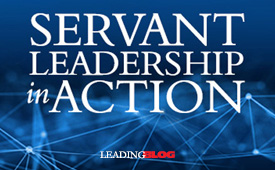 |
 |
02.16.11

Frances Hesselbein: To Serve is To Live
FRANCES HESSELBEIN is a remarkable leader because she doesn’t try to get others to think of her as a leader, she tries to get others to think of themselves as leaders. Reading her autobiography, My Life in Leadership, I was struck by the importance she places on inclusion, respect, civility, decency, honor, honesty and faithfulness. It’s not surprising then, that she never thought of herself as a “woman leader,” but always as “a leader who is a woman.” Hesselbein didn’t start out to be a leader, but she became one by expressing her best self in all that she did. An example for all would-be leaders to follow. Her mantra is, “to serve is to live.” Her father was her hero and when he died, she dropped out of college to help support her family. Later she married and raised a family with no intention of leaving her hometown in Pennsylvania. Later to help out, she volunteered to serve as a Girl Scout Troop leader. Eventually, as doors opened for both her and her husband, she was asked to head the Girl Scouts of the USA which she did from 1976 to 1990. From her contribution there, she was named “Best Nonprofit Manager in America” by Fortune Magazine. In 1998 she was awarded the Presidential Medal of Freedom in recognition of her exemplary leadership as CEO of Girl Scouts of the USA, her role as the founding president of the Drucker Foundation, and her service as “a pioneer for women volunteerism, diversity, and opportunity.” My Life in Leadership is full of lessons. Here are just five of the lessons she has learned along the way. I’m certain you’ll find at least one that will improve your leadership approach and thinking. “If we value diversity and inclusion, then we must ask, ‘When they look at us, can they find themselves?’ This is the powerful question that uncovers whether an organization practices what it preaches.” At the Girl Scouts of the USA, she worked hard to make sure people of all races and backgrounds could find themselves in the organization. She writes: “One of the most important parts of transforming a large and complex organization is inclusion: engaging all of the people every step of the way... Inclusion is a powerful value: when we open up the organization, dispersing the leadership, including people from across the enterprise, there is a new energy, a new synergy.” At one point she asked her staff to introduce themselves to each other at a meeting. She shares the story of a staff member that understands what it means to think like a leader—be a leader—no matter where you find yourself in an organization: “My name is Troy. I work in the mail room, and I like to think of myself as the heart of the organization. Everything that comes into the organization comes through me. Everything that goes out of the organization goes through me. I am the heart of the organization!” She adds, “Troy’s ‘heart’ brought to us new insight about the importance of every person and every position. I’ve never forgotten Troy and that moment.” When making a decision about change you can’t stall in indecision but you can’t run over people either. She explains how she handled a touchy situation and then writes: “When does the sled take off? Is the question for all leaders, knowing that we can fail if the sled leaves too early with too few people on it, or we can wait too long, and someone else will have filled the need and eaten our lunch…. It takes managerial courage to decide that it is time for the sled to take off when many are hesitant to climb on board. A leader respects their opinions and their positions, but cannot be deterred by them. Later these people may change their minds and join you, but if you act in a dismissive way that diminishes them, they never come back. Save the face and the dignity of the people who oppose the initiative. That is a key principle in managing change and mobilizing people around that change.” In 1981, at a GSA meeting, Peter Drucker told them: “You do not see yourself life size. You do not appreciate the significance of the work you do, for we live in a society that pretends to care about its children, and it does not.” Hesselbein said, “I wanted to refute this, but could think of nothing to say. Drucker continued, “And for a little while, you give a girl a chance to be a girl in a society that forces her to grow up all too soon.” Hesselbein adds, “We took him seriously.” How many of us see what we do “life size?” Hesselbein says the number one element of listening is “banish the but.” She writes: If we want people to listen, we must banish “but” from our vocabulary. How many times have we had someone tell us how well we performed—and we were feeling good about the feedback, listening carefully—then we heard “but,” and the positive, energizing part of the feedback was lost in the “but” and what followed it. “But” is nobody’s friend—listener or speaker. “And” provides the graceful transition, the non-threatening bridge to mutual appreciation, the communication that builds effective relationships. Hesselbein believes that “in the end, it’s the quality and character of the leader that determines the performance.” As President and CEO of the Peter Drucker Foundation for Nonprofit Management (now the Leader to Leader Institute), she was asked what the two most powerful messages were that he left with her. She said, “Think first, speak last” and, “the leader of the future asks; the leader of the past tells. Ask, don’t tell.” In the foreword, Jim Collins sums up well the example of Frances Hesselbein: No matter what knocks you down, you get up and go forward. You might be appalled by horrifying events, but never discouraged. You might need to deal with mean-spirited and petty people along the way but never lose your own gracious manner. You might need to confront a litany of brutal facts and destabilizing uncertainties, but it is your responsibility, as a leader to always shine a light.   
Posted by Michael McKinney at 06:00 PM
|
BUILD YOUR KNOWLEDGE
 

How to Do Your Start-Up Right STRAIGHT TALK FOR START-UPS 
Grow Your Leadership Skills NEW AND UPCOMING LEADERSHIP BOOKS 
Leadership Minute BITE-SIZE CONCEPTS YOU CAN CHEW ON 
Classic Leadership Books BOOKS TO READ BEFORE YOU LEAD |